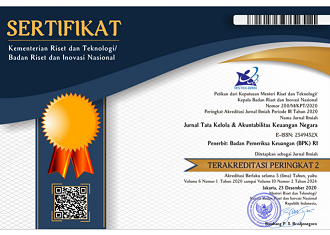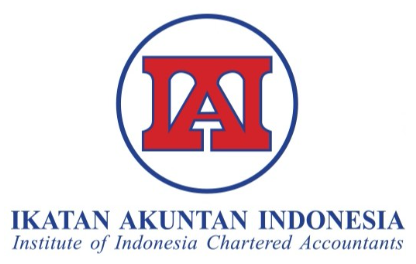The application of the organizational learning perspective in explaining the government's internal auditor’s role development
DOI:
https://doi.org/10.28986/jtaken.v10i1.1565Keywords:
Internal auditor role, internal audit effectiveness, PNBP Minerba, organizational learningAbstract
The management of mineral and coal non-tax state revenue (PNBP Minerba) requires urgent attention and improvement, which can be achieved through appropriate oversight of internal auditors. This study assesses the efficacy of internal audit role development through an organizational learning perspective. Authors interviewed eleven informants from internal auditors of the inspectorate and auditees from the Ministry of Energy and Mineral Resources (KESDM) of the Republic of Indonesia. The data corroborates our theoretical framework within organizational significance theory, which states that the interconnection of the relationship between internal auditors and auditees, the internal audit process, and internal auditor resources culminates in the "results zone." Within this zone, internal audits yield effective outcomes that can positively influence the organization’s significance. This research reveals that auditees feel that an internal auditor’s findings and recommendations can influence their organization. This perspective can enhance PNBP Minerba management system and foster learning and organizational change. However, internal auditor recommendations have not effectively spurred organizational learning in KESDM, implying that KESDM is still in the developmental phase. This study stands out for its qualitative exploration of organizational characteristics, particularly the interplay between internal auditors and auditees, the internal audit process, and internal auditor resources.
References
Ahmad, Z., & Taylor, D. (2009). Commitment to independence by internal auditors: The effects of role ambiguity and role conflict. Managerial Auditing Journal, 24(9). https://doi.org/10.1108/02686900910994827
Arena, M., Arnaboldi, M., & Azzone, G. (2006). Internal audit in Italian organizations: A multiple case study. Managerial Auditing Journal, 21(3), 275-292. https://doi.org/10.1108/02686900610653017
Bapuji, H., & Crossan, M. (2004). From questions to answers: Reviewing organizational learning research. Management Learning, 35(4), 397-417. https://doi.org/10.1177/1350507604048270
Bäßler, T., & Eulerich, M. (2022). Three Lines 4.0 - Predictive Process Monitoring for Internal Audit. SSRN Electronic Journal. https://doi.org/10.2139/ssrn.4080238
Cohen, L., Manion, L., & Morrison, K. (2018). Research methods in education sixth edition. Routledge.
Creswell, J. W. (2009). Research design: Qualitative, quantitative, and mixed methods approaches (Issue 3). Sage Publications.
Gilson, C., Dunleavy, P., & Tinkler, J. (2007). Organizational learning in government sector organizations: Literature review. LSE Public Policy Group. http://eprints.lse.ac.uk/59228/1/Gilson_Dunleavy_Tinkler_Organizational-learning-in-government-sector-organizations_2009.pdf
Hartono, J. (2018). Metoda pengumpulan dan teknik analisis data. Penerbit Andi.
Hermanson, D. R., & Rittenberg, L. E. (2003). Internal audit and organizational governance. The Institute of Internal Auditors Research Foundation.
Khelil, I., & Khlif, H. (2022). Internal auditors’ perceptions of their role as assurance providers: a qualitative study in the Tunisian public sector. Meditari Accountancy Research, 30(1). https://doi.org/10.1108/MEDAR-04-2020-0861
Kloot, L. (1997). Organizational learning and management control systems: Responding to environmental change. Management Accounting Research, 8(1), 47–73. https://doi.org/10.1006/mare.1996.0033
Law of The Republic of Indonesia Number 9 of 2018 concerning Non-tax state revenue (Undang-Undang Republik Indonesia Nomor 9 Tahun 2018 tentang Penerimaan Negara Bukan Pajak). https://peraturan.bpk.go.id/Details/90041/uu-no-9-tahun-2018
Lenz, R., & Hahn, U. (2015). A synthesis of empirical internal audit effectiveness literature pointing to new research opportunities. Managerial Auditing Journal, 30(1), 5-33. https://doi.org/10.1108/MAJ-08-2014-1072
Lenz, R., & Sarens, G. (2012). Reflections on the internal auditing profession: What might have gone wrong? Managerial Auditing Journal, 27(6), 532–549. https://doi.org/10.1108/02686901211236382
Lenz, R., Sarens, G., & D’Silva, K. (2014). Probing the discriminatory power of characteristics of internal audit functions: Sorting the wheat from the chaff. International Journal of Auditing, 18(2), 126-138. https://doi.org/10.1111/ijau.12017
Presidential Instruction (Inpres) Number 4 of 2018 concerning Increasing Supervision of Tax Revenues on Government Expenditures and Non-Tax State Revenues (Instruksi Presiden Nomor 4 Tahun 2018 tentang Peningkatan Pengawasan Penerimaan Pajak atas Belanja Pemerintah dan Penerimaan Negara Bukan Pajak). https://peraturan.bpk.go.id/Details/77299/inpres-no-4-tahun-2018
Ridder, H. G., Miles, M. B., Michael Huberman, A., & Saldaña, J. (2014). Qualitative data analysis. A methods sourcebook. Zeitschrift Fur Personalforschung, 28(4), 485–487. https://www.jstor.org/stable/24332877
Ridley, J. (2015). Cutting-edge internal auditing. John Wiley & Sons. https://doi.org/10.1002/9781119208440
Roussy, M. (2013). Internal auditors’ roles: From watchdogs to helpers and protectors of the top manager. Critical Perspectives on Accounting, 24(7–8), 550–571. https://doi.org/10.1016/j.cpa.2013.08.004
Roussy, M., Barbe, O., & Raimbault, S. (2020). Internal audit: From effectiveness to organizational significance. Managerial Auditing Journal, 35(2), 322-342. https://doi.org/10.1108/MAJ-01-2019-2162
Roussy, M., & Brivot, M. (2016). Internal audit quality: A polysemous notion? Accounting, Auditing and Accountability Journal, 29(5), 714-738. https://doi.org/10.1108/AAAJ-10-2014-1843
Silverman, D. (2013). Doing qualitative research: A practical. Sage Publications.
Sinaga, H. D. P., Pramugar, R. N., & Wirawan, A. (2020). Reconstruction of criminal provisions for non-tax state revenue: A case study in the mining sector in Indonesia. Ayer Journal, 27(3), 141-154.
Soh, D. S. B., & Martinov-Bennie, N. (2015). Internal auditors’ perceptions of their role in environmental, Social, and governance assurance and consulting. Managerial Auditing Journal, 30(1), 80-111. https://doi.org/10.1108/MAJ-08-2014-1075
Tarjo, T., Anggono, A., Musyarofah, S., Haryadi, B., Nurhayati, N., As‘ad, A., & Mulyawan, S. (2020). Three lines of defense: Paradigm supporting roles of internal audit to prevent corruption in Indonesia regional government. Proceedings of the First International Conference on Financial Forensics and Fraud, ICFF, Indonesia. https://doi.org/10.4108/eai.13-8-2019.2294266
Volodina, T., Grossi, G., & Vakulenko, V. (2022). The changing roles of internal auditors in the Ukrainian central government. Journal of Accounting and Organizational Change, 19(6), 1-23. https://doi.org/10.1108/JAOC-04-2021-0057
Yamin, N. Y., Amir, A. M., & Angraini, M. (2018). The management of non-tax revenue: An evaluative review. Proceedings of the 3rd International Conference on Education, Sports, Arts and Management Engineering (ICESAME 2018), 432-435. Atlantis Press. https://doi.org/10.2991/amca-18.2018.119
Downloads
Submitted
Accepted
Published
How to Cite
Issue
Section
License
Copyright (c) 2024 Jurnal Tata Kelola dan Akuntabilitas Keuangan Negara

This work is licensed under a Creative Commons Attribution-ShareAlike 4.0 International License.

Jurnal Tata Kelola dan Akuntabilitas Keuangan Negara is licensed under
a Creative Commons Attribution-ShareAlike 4.0 International License





















